|
MiG-15 Quattro Combo
Royal Class
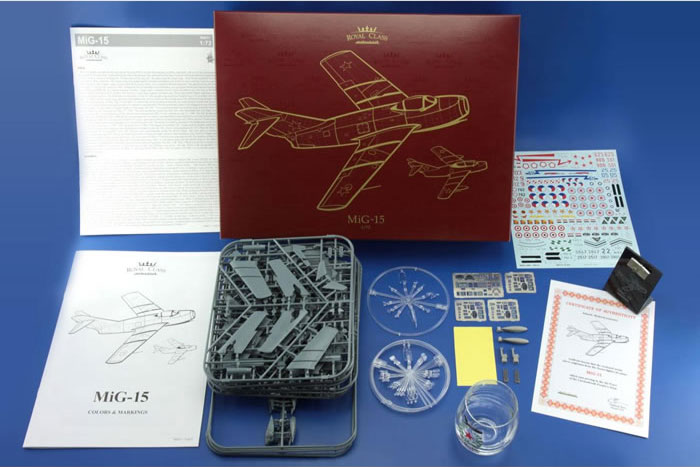
Eduard, 1/72 scale
S
u m m a r y |
| Catalogue Number: |
Eduard Kit No.R0011 – MiG-15 Quattro Combo (Royal Class) |
| Scale: |
1/72 |
| Contents and Media: |
Approximately 364 grey and 37 clear styrene parts, four coloured PE frets, canopy paint masks, and 18 decal options; sufficient to build three ‘Fagots’ and a ‘Midget’, or more precisely - 1 x MiG-15, 2 x MiG-15bis, and 1 x MiG-15 UTI.
Two resin ejection seats and two 300 litre slipper-style drop tanks are included for use with any, but not all of the four kits.
One small crystal glass emblazoned with a MiG-15, wreathed Soviet Star, and Eduard logo.
One plastic plinth with a MiG-15 outline and Eduard Logo and displaying a 5cm2 section of Czech MiG-15 airframe skin, complete with certificate of authenticity. |
| Price: |
Available online from:
Click for currency conversion. |
| Review Type: |
FirstLook |
| Advantages: |
Superb quality components and decals, nice choice of markings. The best MiG-15 kits in their scale by far. |
| Disadvantages: |
None noted. |
| Conclusion: |
Eduard’s Royal Class MiG-15 boxing is a quality package through and through. It is not for me to second-guess Eduard’s marketing strategies, but as a modeller I would have chosen to have more detail accessories and decal options in preference to a glass and square of aircraft skin, but no doubt these novelties add to the collector appeal of this issue.
This gripe aside, the quality of the contents is superb. In my view the plastic is Tamiya quality, whilst the decals are better than those offered by this leading Japanese brand. The addition of coloured PE details and a dash of resin just help to elevate the package’s standing even further.
The really welcome addition is the new tool MiG-15UTI, which now joins its MiG-15 and MiG-15bis siblings as being the best in its class. I am sure many will be waiting with baited breath for the Weekend and Profipack Editions of this new “Midget”.
The price of the Quattro Combo is the same as buying four single Profipack boxings, with the added bonus of two resin seats, two 300 litre slipper-tanks, a nice glass, and a certified MiG-15 memento. So provided you want four MiG-15 variants (including two bis), this package is very good value indeed.
Eduard’s are clearly the best MiG15 kits in ‘The One True Scale’. I happily recommend the Royal Class boxing to those who like this sort of package, and unconditionally recommend any single-boxing of the three kits it contains. |
Reviewed by Mark Davies

Eduard's 1/72 MiG-15 Royal Class is available online from Squadron.com
The Mikoyan-Gurevich MiG-15 (Fagot) surprised Western forces upon its service debut, and outclassed the Western fighters it opposed in the Korean War until the United Nation fielded North American F-86 Sabres to counter it. Both designs were the amongst the first widely deployed swept-wing fighter designs, and both would achieve well-deserved iconic status.
The MiG-15 exploited captured German aerodynamic research and, just as importantly, a license-built British Rolls-Royce Nene jet. The latter came about as a result of late-1940’s British government lunacy to share technology in accordance with a wartime offer; despite the onset of the cold-war. Much of the credit is of course also due to the MiG design Bureau, as far more was involved than simply cobbling together other nations’ ideas.
The MiG-15 effectively founded a dynasty of jet-fighters, and one of the most widely produced aircraft ever; with around 18,000 built when licensed production outside of the Soviet Union is included. Without doubt, it is one of the most widely used post-WW2 fighters, and introduced jet-powered warplanes to a multitude of air forces. Several still fly today in private hands as Warbirds, and perhaps there are still be some two-seat MiG-15UTI (Midget) trainer versions in military service somewhere.
Click on Wikipedia for more insight into the MIG-15’s history, development and service.
New Tool MiG-15UTI
Eduard’s eagerly awaited MiG-15UTI, has its debut as part of this Royal Boxing, which is no doubt sound marketing, as some who can wait no longer for Eduard’s twin-seater may be tempted to buy the Royal Class boxing rather than wait for the inevitable Weekend and Profipack Editions.
For me this new tooling is of more significance than the other Royal Class novelties included in this review sample, so I shall focus first on this new kit.
Obviously the UTI kit shares parts with the other two kits, but despite this, only one sprue is 100% common with the other two. This is ‘Sprue B’ with the wings, tailplane, rudder, and the jet-pipe used for the MiG-15 boxing. The two new grey sprues, ‘G & H’, provide the UTI’s fuselage components, cockpit, wheels (with the same choice of hub styles as the other two kits), a wider MiG-15bis jet-pipe, and common to all drop-tank choices. Obviously, the clear sprue also differs from the previous kits because of the two-place canopy, as does the coloured PE fret for the same reason. The canopy paint mask is also different of course, but this is supplied on a common sheet with the masks for the other three kits.
The instructions are part of an A4 booklet covering all four kits, with separate section for each variant. The quality and style of this is excellent, with clear easily followed illustrations (with one small exception), printed on glossy paper. The style is the same as found in Profipack Editions, other than that the colours & markings guide is provided as a separate booklet.
The exception to instructional clarity mentioned above concerns the jet-pipe for the UTI. The four-kit instructional booklet clearly shows that for the UTI that the jet-pipe halves on ‘Sprue B’ (the wings) is to not be used, and that the jet-pipe supplied on ‘Sprue H’ (the UTI fuselage sprue) should be used; which all seems logical enough. However, loose in the box is small square sheet of paper with a parts map showing ‘Sprues B & H’ that directs the jet-pie from ‘B’ be used and that on ‘H’ ignored.
The explanation seems to be that the UTI’s ‘Sprue H’ has the same slightly wider jet-pipe as used by the MiG-15bis, whereas the narrower initial MiG-15 type found on ‘Sprue-B’ should be used for the UTI. No doubt the instructions will be corrected by the time the UTI is released in Weekend and Profipack Editions.
No less than seven of the eighteen Royal Class decal options relate to the single UTI kit, and are printed by Cartograf. The ‘lesser’ Weekend and Profipack Editions usually have two and five decal options respectively. The MiG-15UTI markings options are:
-
1st Fighter Regiment, 2nd Squadron, Plana Air Base, Czechoslovakia, summer, 1969.
-
822028, Havittajalentolaivue 31, Rissala Air Base, Finland, May, 1973.
-
Syrian Air Force.
-
612739, Flown by Yuri Gagarin/Vladimir Seryogin, Space Training Centre, Chkalovskiy Airfield, Soviet Union, March 27, 1968.
-
Egyptian Air Force, 1970s & 80s.
-
Indonesian Air Force, Kemajoran Air Base, Jakarta 1965.
-
Iraqi Air Force, 1980s.
As with the earlier Eduard MiG-15 kits, the UTI is straightforward with a conventional parts breakdown, and is well-engineered. Parts are crisply moulded with delicate recessed surface detail, and include some quite fine pieces. Assembly is essentially the same as described in the linked MiG-15 ‘first look’ mentioned earlier, so I shall not repeat it here. I shall however mention the UTI’s cockpits.
The cockpit is very well detailed for the scale, in part due to the use pre-coloured PE, although this is optional in the case of the instrument and side panels, where decals may be use instead (most will opt to use the coloured PE I think).
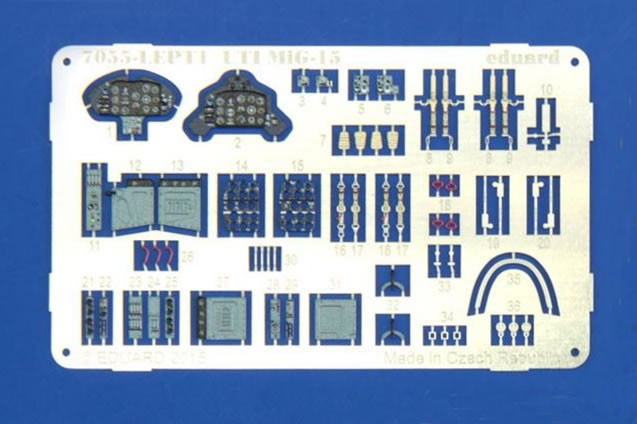
There are very nicely done seats, detailed control columns, PE rudder pedals and various small controls. The cockpit and nose wheel-well are enclosed within the intake trunking as per the original plane. The three-piece canopy is acceptably thin and very clear, and can be modelled open or closed. I think that the cockpits look superb when finished as these cropped images from Eduard’s website illustrate.
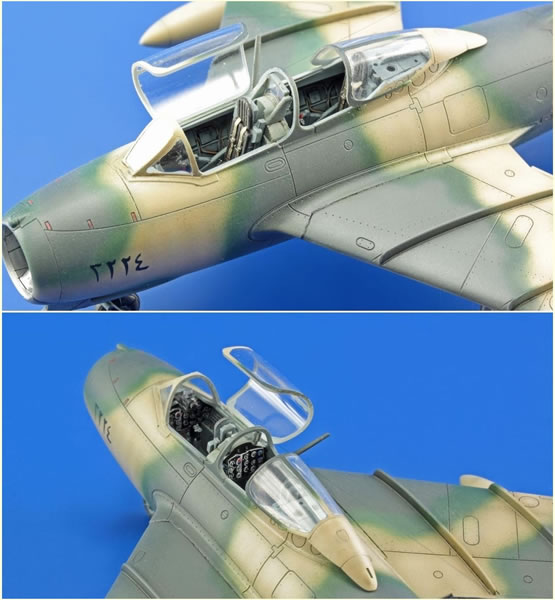
The Royal boxing includes optional two resin ejection seats that use the same PE belts as the styrene ones. These can either be used with the UTI or any of the other three MiG-15 kits. Likewise, there are two resin 300 litre slipper-style drop-tanks that can be used on any one of the four kits provided.
The old Kovozavody Prostejov MiG-15UTI was bettered by the still nice, if basic, Hobby Boss kit. But now we have the definitive Midget in the 1/72-scale from Eduard. It has been well worth the wait; just take a look at this finished model on Eduard’s website by clicking here and here.
Royal Class Contents
The contents come in a top-opening box that weighs in at a hefty 1kg. The sprues and decals are enclosed in resealable cellophane bags, whilst the masks and PE frets come in zip-lock polythene bags. There are also two small internal boxes, one containing a glass wrapped in tissue, the other six resin parts cushioned in foam.
The instructions consist of 20 glossy colour printed A4 pages, whilst the colours & markings guide is 32 pages of the same. Both feature English and Czech text, and are very appealing in appearance due to their excellent quality. The instructions can be viewed or downloaded as a PDF here and the colours & markings guide here.
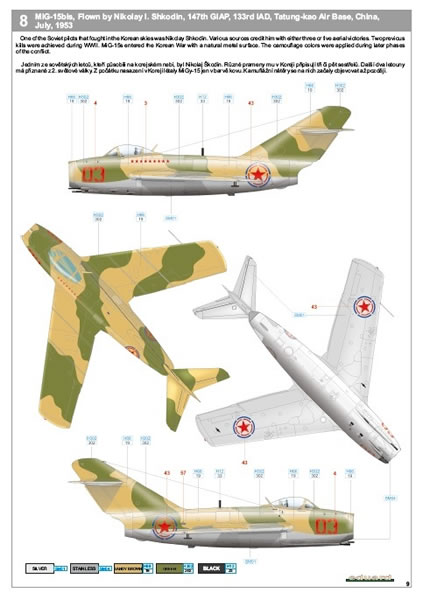
The four variations covered by the Royal Class issue are one MiG-15, two MiG-15bis and one MiG-15UTI. All are provided with the same parts as you would expect to get with A Profipack Edition; namely, the same grey and clear sprues, and the same coloured PE fret.
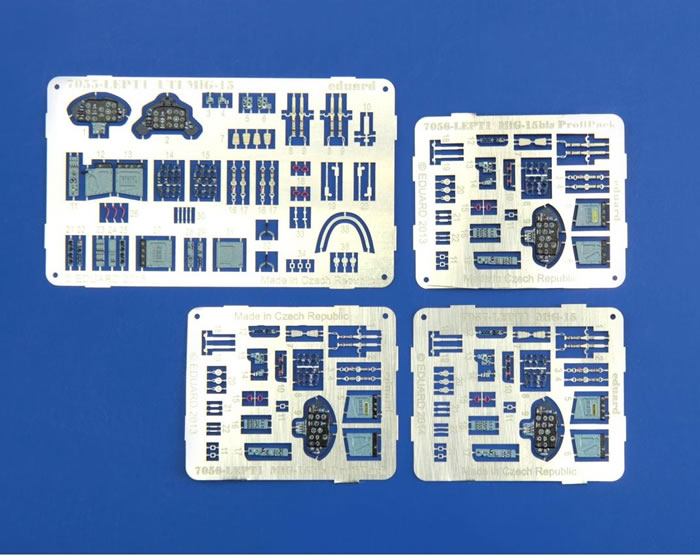
However, rather than four individual canopy paint masks there is one sheet with masks for all four kits (no doubt allowing a reduction in Kabuki tape used).
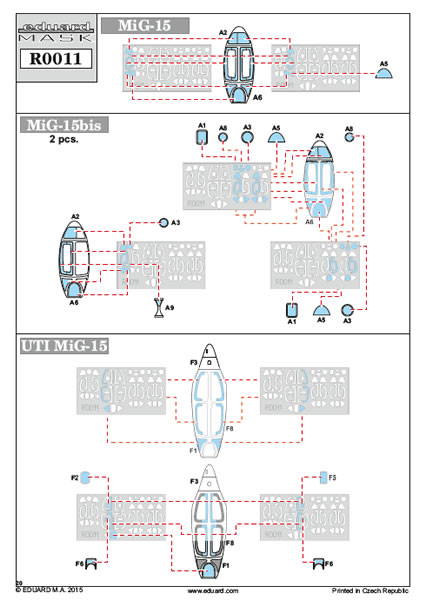
As mentioned in above in the section dealing with the new tool MiG-15UTI, the Royal Boxing includes two resin ejection seats (two parts each) that are garnished with the same PE belts as the kits’ styrene seats. There are also two resin 300 litre slipper-style drop-tanks. These resin items can be used with any one of the four kits. I can understand perhaps a single option for the 300 litre drop-tanks, but it seems odd to include only two seats when the kits account for five.

The only logic I can think of to explain this is production cost in relation to the targeted price-point, and the supposition that too much cost went into the Mig-15 skin plinths and certificate and the emblazoned glass. I concede that these items will appeal to some; they are essentially marketing gimmicks in my opinion. I would prefer to have sufficient resin seats, or any other Brassin accessories or exterior PE sets to use with my models. Eduard no doubt knows their market, and presumably Royal Class releases have a collector following, in which case the novelties make more sense.
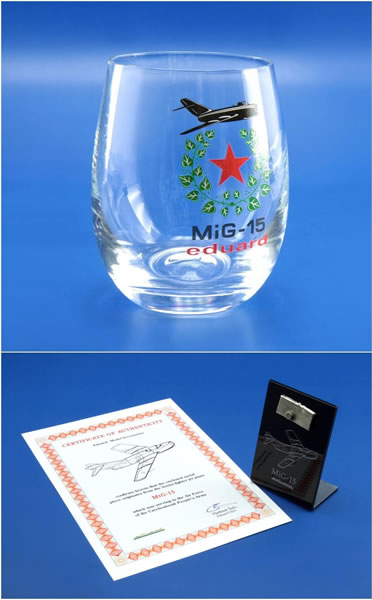
Decals and Colours & Markings Guide
The 19-page colours & markings guide is delight to behold, and with 18 options, some of which are quite colourful and interesting.
I recently reviewed the Eduard Avia B.534 Royal Class boxing, and that offered no less than 31 decal options, whereas the MiG-15 Royal Class just seven for the UTI kit, leaving two options for the single MiG-15 kit, and nine for the two MiG-15bis kits; so not an average of just over four per kit. Again I cannot but help think that the glass and airframe skin fragment have impacted the money left to offer decals options.
The choices, excluding the MiG-15UTI schemes listed earlier, are:
-
MiG-15, 111025, flown by 1st Lt. Anatoliy P. Gogolev, 2nd Flight, 176th GIAP, 324. GIAD, Antung Air Base, 1951.
-
MiG-15, 231611, Romanian Air Force, late 1950s
-
MiG-15bis, No. 20 Squadron, Egypt, late 1950s/early 1960s
-
MiG-15bis, flown by Capt. Ryszard Grundman, 1st Fighter Regiment, Bemowo Air Base, Poland, 1954.
-
MiG-15bis, 31530906, 25th Fighter Division, 35th Fighter Regiment, Taszar Air Base, Hungary, 1954 – 1955
-
MiG-15bis, 623766, FAG 2 Training Regiment, Trollenhagen Air Base, German Democratic Republic, 1956.
-
MiG-15bis, flown by Zhao Baotong, 3rd Air Division, Korea, 1952
-
MiG-15bis, flown by Nikolay I. Shkodin, 147th GIAP, 133rd IAD, Tatung-kao Air Base, China, July, 1953
-
MiG-15bis, Korea, 1952.
-
MiG-15bis, flown by Capt. Jaromir Palecny, 11th Fighter Regiment, Zatec Air Base, 1960.
-
MiG-15bisSB, 30th Fighter-Bomber Regiment, Hradec Kralove/Pardubice Air Base, Czechoslovakia, 1970s.

Painting is made easier by the inclusion of a single-sheet of canopy masks for all four kits consisting of pre-cut Kabuki tape. The decals of course appear to be excellent as would be expected from Cartograf.
Eduard’s Royal Class MiG-15 boxing is a quality package through and through. It is not for me to second-guess Eduard’s marketing strategies, but as a modeller I would have chosen to have more detail accessories and decal options in preference to a glass and square of aircraft skin. But no doubt these novelties add to the collector appeal of this issue.
This gripe aside, the quality of the contents is superb. In my view the plastic is Tamiya quality, whilst the decals are better than those offered by this leading Japanese brand. The addition of coloured PE details and a dash of resin just help to elevate the package’s standing even further.
The really welcome addition is the new tool MiG-15UTI, which now joins its MiG-15 and MiG-15bis siblings as being the best in its class. I am sure many will be waiting with baited breath for the Weekend and Profipack Editions of this new “Midget”.
The price of the Quattro Combo is the same as buying four single Profipack boxings, with the added bonus of two resin seats, two 300 litre slipper-tanks, a nice glass, and a certified MiG-15 memento. So provided you want four MiG-15 variants (including two bis), this package is very good value indeed.
Eduard’s are clearly the best MiG15 kits in ‘The One True Scale’. I happily recommend the Royal Class boxing to those who like this sort of package, and unconditionally recommend any single-boxing of the three kits it contains.
Thanks to Eduard for the sample
Review Text Copyright © 2015 by Mark Davies
Page Created 31 August, 2015
Last updated
1 September, 2015
Back to HyperScale Main Page
Back to Reviews Page |
